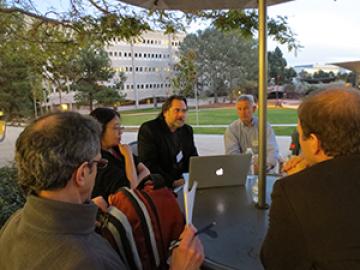Filter News
Area of Research
- (-) Computational Chemistry (5)
- (-) Neutron Science (190)
- (-) Renewable Energy (4)
- Advanced Manufacturing (34)
- Biological Systems (18)
- Biology and Environment (177)
- Biology and Soft Matter (5)
- Building Technologies (12)
- Chemical and Engineering Materials (4)
- Chemistry and Physics at Interfaces (11)
- Clean Energy (522)
- Climate and Environmental Systems (14)
- Computational Biology (6)
- Computational Engineering (5)
- Computer Science (19)
- Data (1)
- Earth Sciences (1)
- Electricity and Smart Grid (3)
- Energy Frontier Research Centers (14)
- Energy Sciences (5)
- Fossil Energy (3)
- Fuel Cycle Science and Technology (3)
- Functional Materials for Energy (16)
- Fusion and Fission (54)
- Fusion Energy (17)
- Geographic Information Science and Technology (3)
- Isotope Development and Production (3)
- Isotopes (35)
- Materials (433)
- Materials Characterization (2)
- Materials for Computing (36)
- Materials Synthesis from Atoms to Systems (13)
- Materials Under Extremes (12)
- Mathematics (1)
- National Security (79)
- Neutron Data Analysis and Visualization (4)
- Nuclear Science and Technology (74)
- Nuclear Systems Modeling, Simulation and Validation (3)
- Nuclear Systems Technology (1)
- Quantum Condensed Matter (4)
- Quantum information Science (9)
- Reactor Technology (1)
- Sensors and Controls (5)
- Supercomputing (311)
- Transportation Systems (11)
News Type
News Topics
- 3-D Printing/Advanced Manufacturing (6)
- Advanced Reactors (1)
- Artificial Intelligence (6)
- Big Data (2)
- Bioenergy (6)
- Biology (5)
- Biomedical (11)
- Biotechnology (1)
- Chemical Sciences (2)
- Clean Water (2)
- Climate Change (1)
- Composites (1)
- Computer Science (13)
- Coronavirus (8)
- Cybersecurity (1)
- Decarbonization (2)
- Energy Storage (6)
- Environment (8)
- Fossil Energy (1)
- Frontier (1)
- Fusion (1)
- High-Performance Computing (2)
- Hydropower (1)
- Machine Learning (3)
- Materials (14)
- Materials Science (23)
- Mathematics (1)
- Microscopy (3)
- Nanotechnology (10)
- National Security (2)
- Neutron Science (99)
- Nuclear Energy (3)
- Physics (9)
- Polymers (1)
- Quantum Computing (1)
- Quantum Science (7)
- Security (2)
- Space Exploration (3)
- Summit (6)
- Sustainable Energy (2)
- Transportation (5)
Media Contacts

The efficiency of solar cells depends on precise engineering of polymers that assemble into films 1,000 times thinner than a human hair.
Today, formation of that polymer assembly requires solvents that can harm the environment, but scientists at the Department of En...

For early career researchers, a fellowship can be a valuable foot in the door, exposing them to the opportunity to gain experience in areas of science and technology of national importance.

Crude oil refinement can be an extremely costly chemical process. In an effort to reduce energy and cost demands, Oak Ridge National Laboratory researchers Anibal Ramirez-Cuesta and Stuart Campbell are collaborating with University of Nottingham (UK) researchers to develop metal-orga...

Groundbreaking work at two Department of Energy national laboratories has confirmed plutonium’s magnetism, which scientists have long theorized but have never been able to experimentally observe. The advances that enabled the discovery hold great pro...

Scientists at the US Department of Energy’s Oak Ridge National Laboratory are learning how the properties of water molecules on the surface of metal oxides can be used to better control these minerals and use them to make products such as more efficient semiconductors for organic light emitting diodes and solar cells, safer vehicle glass in fog and frost, and more environmentally friendly chemical sensors for industrial applications.

For more than 50 years, scientists have debated what turns particular oxide insulators, in which electrons barely move, into metals, in which electrons flow freely.

Throw a rock through a window made of silica glass, and the brittle, insulating oxide pane shatters. But whack a golf ball with a club made of metallic glass—a resilient conductor that looks like metal—and the glass not only stays intact but also may drive the ball farther than conventional clubs. In light of this contrast, the nature of glass seems anything but clear.

Complex oxides have long tantalized the materials science community for their promise in next-generation energy and information technologies. Complex oxide crystals combine oxygen atoms with assorted metals to produce unusual and very desirable properties.

When Orlando Rios first started analyzing samples of carbon fibers made from a woody plant polymer known as lignin, he noticed something unusual. The material’s microstructure -- a mixture of perfectly spherical nanoscale crystallites distributed within a fibrous matrix -- looked almost too good to be true.

The Department of Energy’s Oak Ridge National Laboratory concluded a series of workshops this month that engaged scientists from around the country to identify grand scientific challenges and how they might be addressed through application of neutron science.




